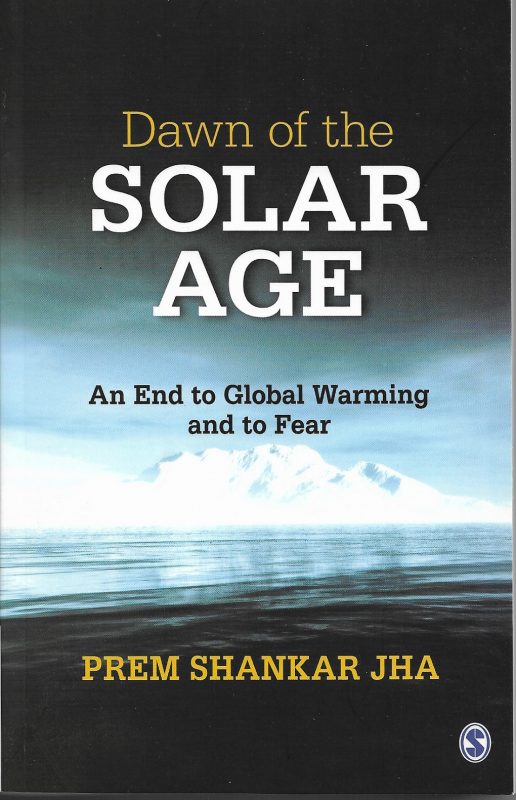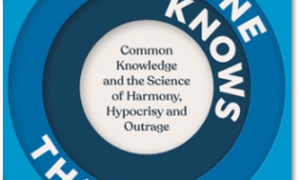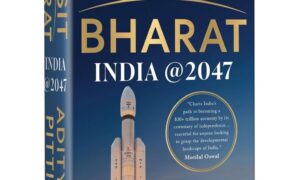
At a time when the global effort to counter climate change hangs in the balance, Prem Shankar Jha has delivered a powerful message in his new book, “Dawn of the Solar Age: an end to the global warming and to fear ”.
The book is all the more significant coming from a distinguished Indian journalist deeply immersed in Indian economic and energy policy. The author has been an adviser to the Prime Minister, economics editor of the Times of India, and a member of the energy panel of the Brundtland Commission. India is expected to become the most populous nation on earth and it stands on the verge of economic take-off. As India crafts its development pathway some of the most important decisions, perhaps the most important decisions, for the future of the planet will be made in New Delhi. We should take notice of this Indian perspective.
The book opens with a stark warning of the threat that climate change presents to humanity. Mr Jha believes that the outlook is even more ominous and the need for action even more urgent than the official international expert group (the Intergovernmental Panel on Climate Change) has yet recognised.
The central insight of the book is that, because of this urgency, we need technologies that are available now on the necessary scale and that can fit into existing energy infrastructures with the lowest social and physical adjustment costs. This may come as a surprise to some for whom the “disruptive” nature of new technology has become a watchword. But there is obvious force in the argument.
It leads the author to the conclusion that the best chance of saving the planet rests on two key technologies. These are concentrated solar power (CSP) and methanol from biomass gasification.
In CSP an array of mirrors focuses sunlight to heat liquid in a boiler. The hot liquid generates electricity through a steam turbine. An advantage which the author highlights is that the hot liquid is a store of energy, enabling continuous electricity production, even at night. Also, because the back end is a conventional steam turbine, new CSP plants can fit into existing electricity networks in exactly the same way as conventional fossil plant. The alternative solar system, known as photovoltaics (PV), is in much greater use today. But the output is more variable, because it converts sunlight directly into electricity.
A wide range of municipal garbage can be converted first into synthetic gas and then into methanol through high temperature chemical processing. Methanol can displace petrol for light vehicles without major changes to fuel delivery infrastructures or engines.
A further advantage of methanol is that can also be made, in a similar way, from all kinds of crop residue. It could significantly enhance the incomes of farmers and, because residue is costly to transport in bulk, could also promote distributed electricity generation in small country towns. Mr Jha waxes elegiac on how his proposals can lead to a more harmonious relationship between industry and agriculture, cities and the countryside. “Replacing fossil fuels with solar and biomass energy will rejoin the umbilical cord between industry and agriculture that was severed when Europe shifted from wind and water to coal”.
In India the agricultural sector remains by far the largest employer. So the author is clearly right that, whether one views this from the perspective of human welfare or of raw politics, the options with benefits for agriculture have a big advantage.
India has a severe problem of solid waste management. Mr Jha has been advocating gasification for transport fuel as the solution since 1982, and he makes a strong case for it here. As he points out, this is not a problem confined to developing nations because the landfill option adopted in many developed countries, such as the UK, also has its drawbacks.
The author is not convinced that reducing emissions, on its own, will be enough to limit climate change to acceptable levels. He believes that we will also need to extract carbon dioxide from the atmosphere. He is not alone in this. Since the Paris climate summit set the aspiration of limiting global warming to 1.5 degrees Celsius many analysts have come to the same conclusion.
The proposed method is, once again, based on methanol. Converting CO2 into methanol requires a source of hydrogen. Current methods of extracting hydrogen are expensive and reliant on electric power. But the author sets great store by a new process developed by HyperSolar Inc in California for producing hydrogen from water and sunlight. He believes that hydrogen produced by this process will make it economic to produce motor fuels from CO2 extracted either from the air or from the flue gas of conventional fossil fuelled power stations.
In this the author might be accused of departing from his original principle of sticking to technologies that are already available. HyperSolar is certainly an interesting technology, but it has only just, in 2018, successfully demonstrated its first prototype and has yet to build a hydrogen generation plant.
Mr Jha is a compelling writer with a forthright style and his deep knowledge and commitment to his subject shine through on every page. He wades into the forces that he believes stand in the way of progress in swashbuckling style. “As the need to shift becomes more urgent the effort to… suppress, or at least discredit the emerging technologies that have the greatest capacity to upset current power relations in the world, has steadily gathered momentum”.
Readers will warm to his trenchant defence of climate scientists against a series of politically motivated assaults. But not everyone will agree that the causes of global warming are the “enslavement” of mankind by the hidden hand of the market and the ”betrayal” by governments of their own people to fatten the coffers of the oil lobby. Some will also question his rather dismissive analysis of other important renewable technologies such as wind, photovoltaics, and carbon capture and storage (CCS).
Overall, however, this is an excellent read, giving a fresh perspective on a tough global problem. It is written in compelling style, is full of important insights, and contains much food for thought.
Neil Hirst is Senior Policy Fellow at the Grantham Institute Imperial College London, and author of a new book: “The Energy Conundrum; Climate Change, Global Prosperity, and the Tough Decisions We Have to Make“
This article was originally published in the Third Pole. To read the original article click here :
https://www.thethirdpole.net/en/2018/05/02/book-review-dawn-of-the-solar-age/


















